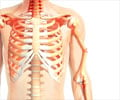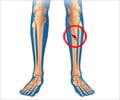New research has revealed that denosumab reversed cortical bone loss and increased bone mineral density, lowering wrist fracture rates in women with osteoporosis.

Denosumab, a fully human monoclonal antibody drug, binds specifically to RANK-ligand (RANKL) and inhibits osteoclast-induced bone resorption by preventing the binding of RANKL to RANK. Cortical bone loss is a major determinant of increased fracture risk. Denosumab has been shown to increase bone mineral density at sites of cortical bone, including the radius, a skeletal site not responsive to most osteoporosis treatments, raising the question of whether these changes affect the risk of fracture at this site.
Researchers in Canada, the United States, France, Austria, Australia, Poland, New Zealand and Estonia conducted a study (FREEDOM) to evaluate changes over time in radius bone mineral density and wrist fracture incidence.
"We examined evaluated changes over time in radius BMD and wrist fracture incidence during three years of placebo (Pbo) and up to five subsequent years of denosumab therapy in FREEDOM and its Extension (EXT)," says study investigator Jacques Brown, MD.
The researchers evaluated 2,207 women who received placebo during the initial three-year trial and then enrolled in the extension trial to receive 60 mg of denosumab once every six months. All the women also received daily calcium and vitamin D supplements. A subset of 115 women participated in a distal radius DXA sub-study. They were evaluated at baseline and during both the FREEDOM and EXT trials. Analysis of mean percentage changes in bone mineral density over time from the two study baselines consisted of a repeated measure model. Wrist fracture rates (per 100 subject-years), rate ratios and 95 percent CI were computed to measure the results.
At the FREEDOM trial baseline, participants'' mean 1/3 radius T-score was -2.53 (1.18). During the original trial, daily calcium and vitamin D alone was associated with a progressive and significant loss of bone mineral density at the 1/3 radius (-1.2%). However, during the extension, denusomab halted and reversed bone loss in the patients.
Advertisement
"In untreated women with postmenopausal osteoporosis, cortical bone density at the radius declined significantly. Denosumab treatment for three years fully reversed this bone loss, and two additional years of treatment resulted in further BMD gains that translated to significantly lower wrist fracture rates. This highlights the clinical importance of reversing cortical bone loss," says Dr. Brown.
Advertisement
 
Paper Number: 1795
JP Bilezikian1, CL Benhamou2, CJF Lin3, JP Brown4, NS Daizadeh3, PR Ebeling5, A Fahrleitner-Pammer6, E Franek7, N Gilchrist8, PD Miller9, JA Simon10, I Valter11, CAF Zerbini12 and C Libanati3, 1College of Physicians and Surgeons, Columbia University, New York, NY, 2CHR d''Orléans, Orléans, France, 3Amgen Inc., Thousand Oaks, CA, 4CHU de Québec Research Centre and Laval University, Quebec City, QC, 5Monash University, Clayton, Australia, 6Medical University, Graz, Austria, 7Medical Research Center, Polish Academy of Sciences, Warsaw, Poland, 8The Princess Margaret Hospital, Christchurch, New Zealand, 9Colorado Center for Bone Research, Lakewood, CO, 10George Washington University, Washington, DC, 11Center for Clinical and Basic Research, Tallinn, Estonia, 12Centro Paulista de Investigação Clinica, São Paulo, Brazil
Background/Purpose: Cortical bone loss is a major determinant of increased fracture risk. Denosumab (DMAb) has been shown to increase BMD at sites of cortical bone, including the radius, a skeletal site not responsive to most osteoporosis treatments. Here, we evaluated changes over time in radius BMD and wrist fracture incidence during 3 years of placebo (Pbo) and up to 5 subsequent years of DMAb therapy in FREEDOM and its Extension (EXT).
Methods: We evaluated 2207 women who received Pbo during FREEDOM (3 years) and enrolled in the EXT to receive DMAb 60 mg Q6M (cross-over group); all women received daily calcium and vitamin D. A subset of these women (n=115) participated in a distal radius DXA substudy and were evaluated at baseline and during FREEDOM and EXT. Analysis of mean percentage changes in BMD over time from FREEDOM and EXT baselines consisted of a repeated measure model. Wrist fracture rates (per 100 subject-years), rate ratios, and 95% CI were computed.
Results: At FREEDOM baseline, the mean (SD) 1/3 radius T-score was -2.53 (1.18). During FREEDOM, daily calcium and vitamin D alone was associated with a progressive and significant loss of BMD at the 1/3 radius (-1.2%); however, during EXT, DMAb halted and reversed bone loss (Figure). With 5 years of DMAb treatment, a significant gain in BMD (1.5% at EXT Year 5) was observed, compared with EXT baseline. The wrist fracture rate during the Pbo period in FREEDOM was 1.02 (0.80-1.29) per 100 subject-years. During the first 3 years of EXT, BMD recovered to the original baseline levels in response to DMAb and the wrist fracture rate remained comparable to the FREEDOM Pbo rate (Table); with 2 additional years of DMAb treatment, BMD increased further and the wrist fracture rate declined to levels significantly lower than the FREEDOM Pbo rate (rate ratio=0.57, 95% CI=0.34-0.95; p=0.03).
Conclusion: In untreated women with postmenopausal osteoporosis, cortical bone density at the radius declined significantly. DMAb treatment for 3 years fully reversed this bone loss, and 2 additional years of treatment resulted in further BMD gains that translated to significantly lower wrist fracture rates, highlighting the clinical importance of reversing cortical bone loss.
Source-Newswise














